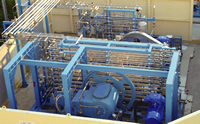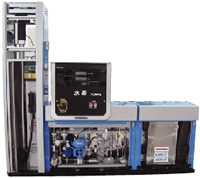Home > About Us > Sustainability Management > Sustainability Report > Sustainability Report 2013 > Contributing to the Environment through Research and Development
 Contributing to the Environment through Research and Development
Contributing to the Environment through Research and Development
Developing Core Technologies to Attain a Hydrogen-Based Society
![]()
Fuel Cell Vehicles (FCVs) will go on general sale in Japan, the United States and Europe from 2015, and construction of hydrogen stations is scheduled in preparation of this event (100 stations by 2015, and 1,000 stations by 2025). The construction of these stations, and popularization of FCVs, is expected to herald the arrival of a new hydrogen-based society. The Kobe Steel Group possesses a variety of technologies that will help contribute to a hydrogen-based society. We would now like to introduce research and development into high-pressure hydrogen compressors and compact heat exchangers, which are core technologies in the construction of hydrogen stations.
Development of High-pressure Hydrogen Compressors for Direct Fueling of FCVs
![]()
With hydrogen stations, the ability to fill an FCV in under three minutes with 100 MPa pressurized hydrogen is important. As a global manufacturer of high-pressure hydrogen compressors for industrial use, Kobe Steel is carrying out collaborative research with the New Energy and Industrial Technology Development Organization (NEDO) into the development of large-scale high-pressure hydrogen compressors for direct fueling of FCVs. Addressing the following steps, we aim to develop practical, compact and low-cost fueling compressors.
- Develop, design and manufacture a compressor prototype, with design discharge pressure of 95 MPa and flow rate of 1,200 Nm3/h (Japanese maximum).
- Achieve a high-pressure compressor unit, including compressor, electric motor, gas cooler, etc., at less than 5m x 2.7m x 3m (H), with inverter control for variable speed operation and reduced energy consumption.
- Verify an operating discharge pressure of 87.5 MPa and flow rate of 1,200 Nm3/h for prototype, and install at model station.
-
Demonstration equipment combined a low-pressure and high-pressure compressor unit into a single unit of 6m x 2.7m x 3m (H), The unit garnered praise for its low noise and vibration during operation.
Through demonstration testing, in addition to collecting data on operation and durability, we are also working to confirm controllability through expansion to the 2,000 Nm3/h class necessary for direct fueling and through fueling tests. We are also pursuing technology development geared toward more compact, lower cost equipment in preparation for the installation and popularization of hydrogen stations after fiscal 2013.
-

High-pressure hydrogen
compressors for direct fueling
Diffusion-Bonded Compact Heat Exchanger (DCHE)
![]()
When fueling an FCV with high-pressure hydrogen, since the hydrogen is re-pressurized within the vehicle's tank, if the tank's temperature rises too high it will be impossible to sufficiently fill the tank. As a result, it is best if hydrogen stations cool the 100 MPa high-pressure hydrogen to -40°C before fueling. Previously, there were no compact heat exchangers capable of cooling gas at a pressure level of 100 MPa, which proved a serious hindrance toward reducing the size of hydrogen stations.
However, the DCHE developed by Kobe Steel requires only 1/30th to 1/100th the installation size of previous double tube type heat exchangers. Diffusion bonding achieves a strength similar in degree to the base welding material, and the DCHE features exceptional pressure resistance (design pressure of 100 MPa), thermal resistance (high and low temperatures) and heat transfer properties. Additionally, as the area of the heat transfer surface is large in comparison to unit volume, compact design is possible, utilizing plate lamination and combinations for multifluid heat exchangers.
The Kobe Steel Group is working toward the realization of hydrogen stations. In addition to developing principal equipment, affiliated company Shinko Engineering and Maintenance Co., Ltd. is participating in overall development and planning.

Diffusion bonding is a method of welding by which welding materials are clamped together and heat, below the metal's melting point, as well as pressure, still within range for minimal plastic deformation, are applied, causing the atoms on the conjoined surfaces to intermingle. (trans. from JIS Z3001 Welding Terms.)

A compact Kobe Steel precooler (right) is installed in a dispenser from Tatsuno Corporation.


